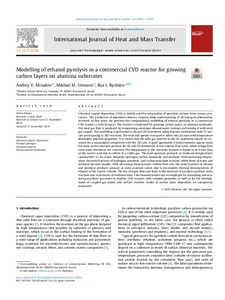Показать сокращенную информацию
Modelling of ethanol pyrolysis in a commercial CVD reactor for growing carbon layers on alumina substrates
| Автор | Andrey V. Minakov | |
| Автор | Mikhail M. Simunin | |
| Автор | Ilya I. Ryzhkov | |
| Дата внесения | 2021-08-13T09:30:21Z | |
| Дата, когда ресурс стал доступен | 2021-08-13T09:30:21Z | |
| Дата публикации | 2019-12 | |
| Библиографическое описание | Andrey V. Minakov. Modelling of ethanol pyrolysis in a commercial CVD reactor for growing carbon layers on alumina substrates [Текст] / Andrey V. Minakov, Mikhail M. Simunin, Ilya I. Ryzhkov // International Journal of Heat and Mass Transfer. — 2019. — Т. 145. | |
| ISSN | 00179310 | |
| URI (для ссылок/цитирований) | https://www.sciencedirect.com/science/article/abs/pii/S0017931019335690?via%3Dihub | |
| URI (для ссылок/цитирований) | https://elib.sfu-kras.ru/handle/2311/142434 | |
| Аннотация | Chemical vapour deposition (CVD) is widely used for preparation of pyrolytic carbons from various precursors. The prediction of deposition kinetics requires deep understanding of all transport phenomena involved. In this work, we perform the computational modelling of ethanol pyrolysis in a commercial CVD reactor (a tube furnace). The reactor is employed for growing carbon layers on alumina substrates. The inlet gas flow is produced by evaporating azeotrope ethanol/water mixture and mixing it with inert gas (argon). The modelling is performed in 3D and 2D statements using Marinov mechanism with 57 species participating in 383 reactions. The heat and species transport is taken into account with temperature dependent physical properties. It is shown that the inlet gas velocity in the 2D statement should be corrected for a meaningful comparison with the 3D case. A good agreement is found between species mole fractions at the substrate position for 3D and 2D statements at low volume flow rates, while at high flow rates some deviations are observed. The temperature at the substrate position is found to be lower than at the reactor wall due to inflow of a colder gas. The main pyrolysis products at moderate temperatures (around 900 C) are water, ethylene, hydrogen, carbon monoxide, and methane. With increasing temperature, the mole fractions of hydrogen, acetylene, and carbon monoxide increase, while those of water and methane become smaller. With increasing ethanol/water volume flow rate, the mole fractions of ethanol and pyrolysis products saturate at some constant values due to incomplete thermal decomposition of ethanol in the reactor volume. The rise of argon flow rate leads to the decrease of pyrolysis products mole fractions due to decrease of residence time. The obtained results can be employed for simulating and analyzing pyrolysis processes in realistic CVD reactors with complex geometry as well as for the development of coupled gas phase and surface reaction model of carbon layer deposition on nanoporous substrates. | |
| Тема | Chemical vapour deposition | |
| Тема | Ethanol pyrolysis | |
| Тема | Chemical kinetics | |
| Тема | Computational modelling | |
| Название | Modelling of ethanol pyrolysis in a commercial CVD reactor for growing carbon layers on alumina substrates | |
| Тип | Journal Article | |
| Тип | Journal Article Postprint | |
| Дата обновления | 2021-08-13T09:30:21Z | |
| Институт | Институт цветных металлов и материаловедения | |
| Институт | Институт космических и информационных технологий | |
| Подразделение | Кафедра композиционных материалов и физико-химии металлургических процессов | |
| Подразделение | Кафедра прикладной математики и компьютерной безопасности | |
| Журнал | International Journal of Heat and Mass Transfer | |
| Квартиль журнала в Scopus | Q1 | |
| Квартиль журнала в Web of Science | Q1 |

